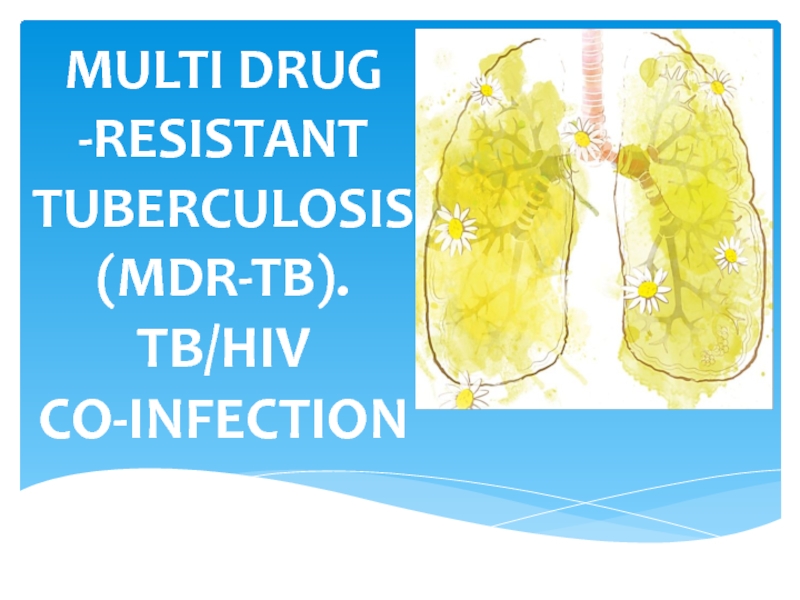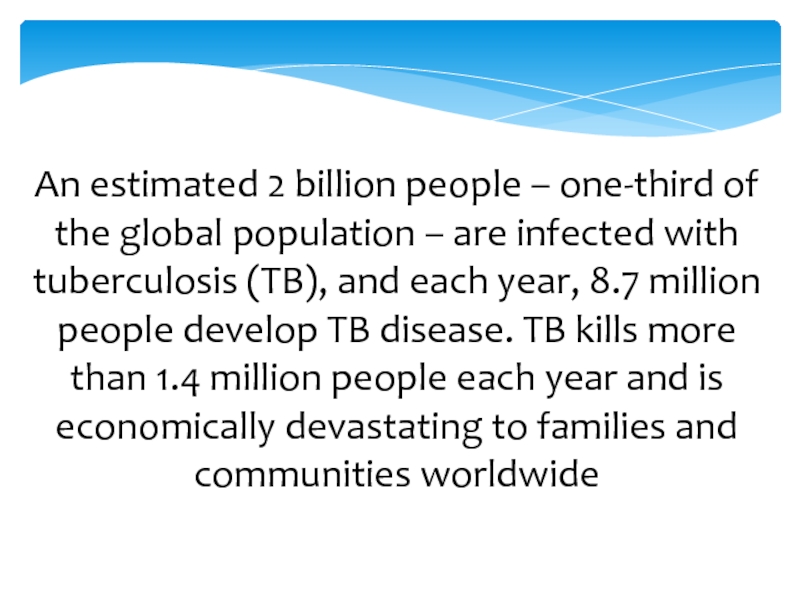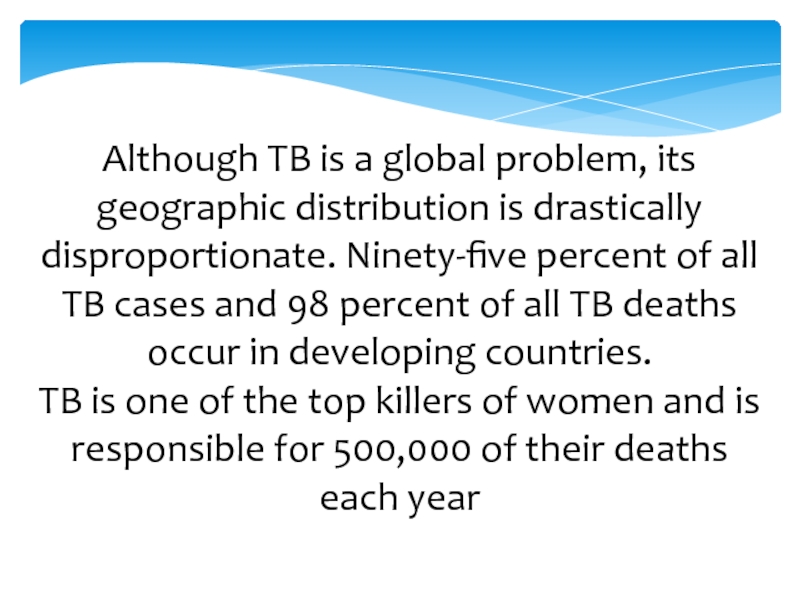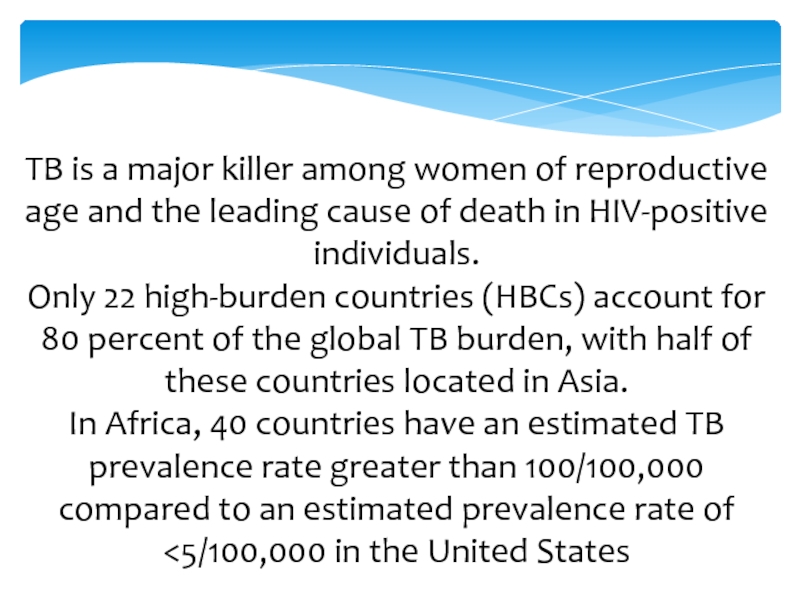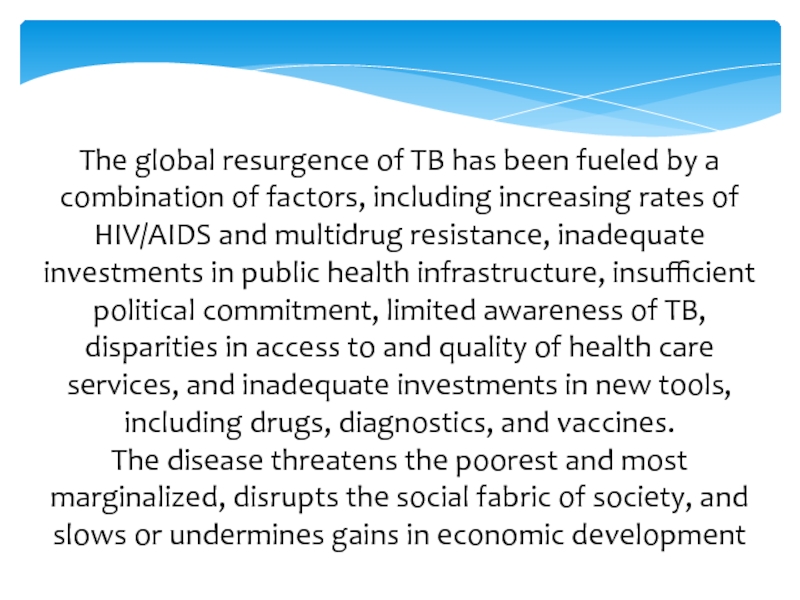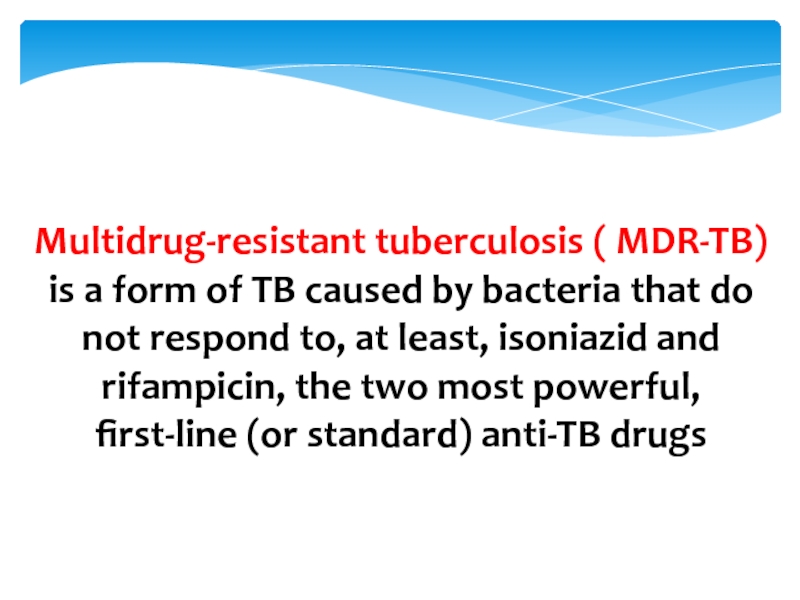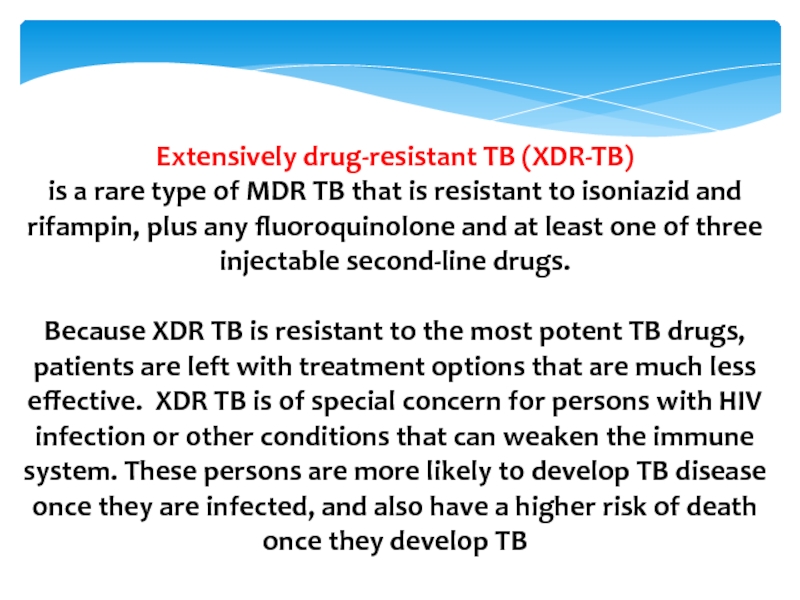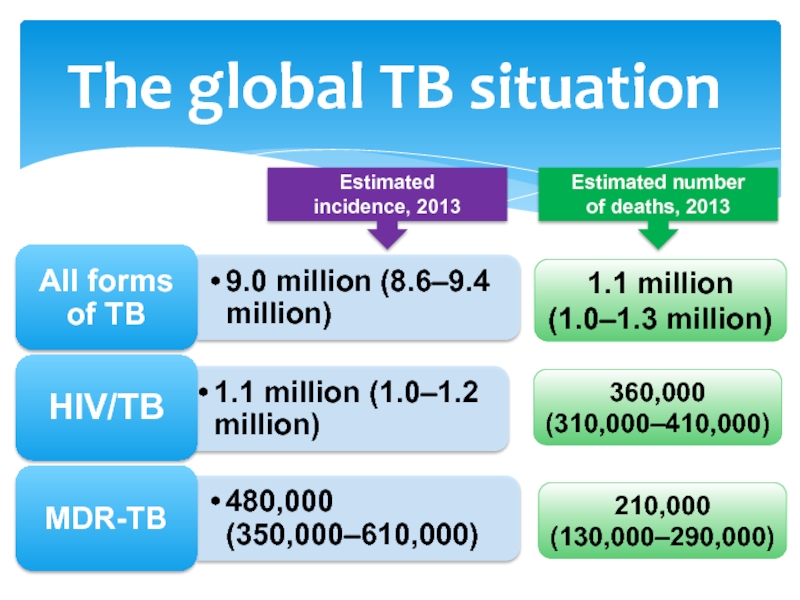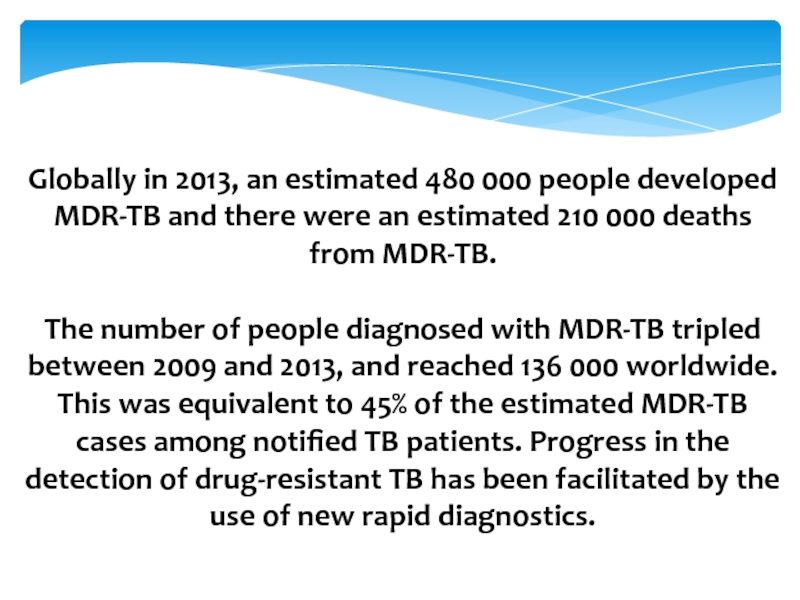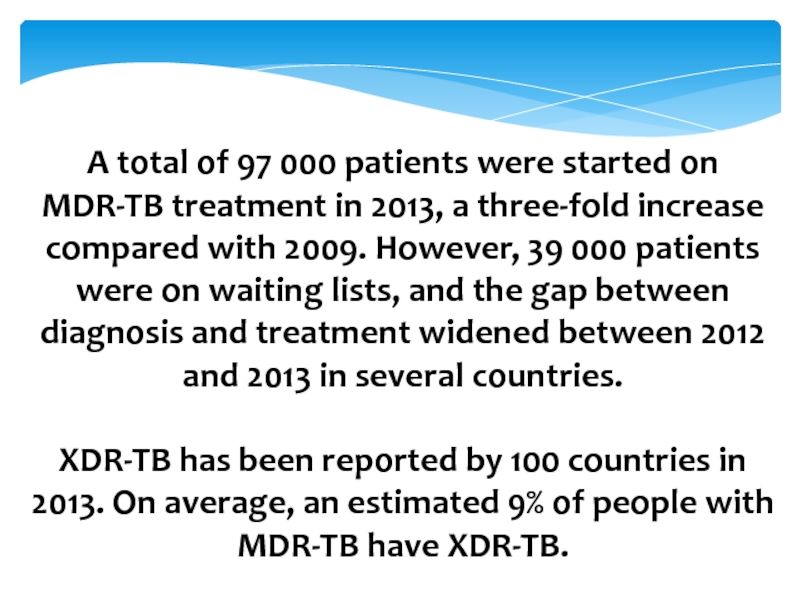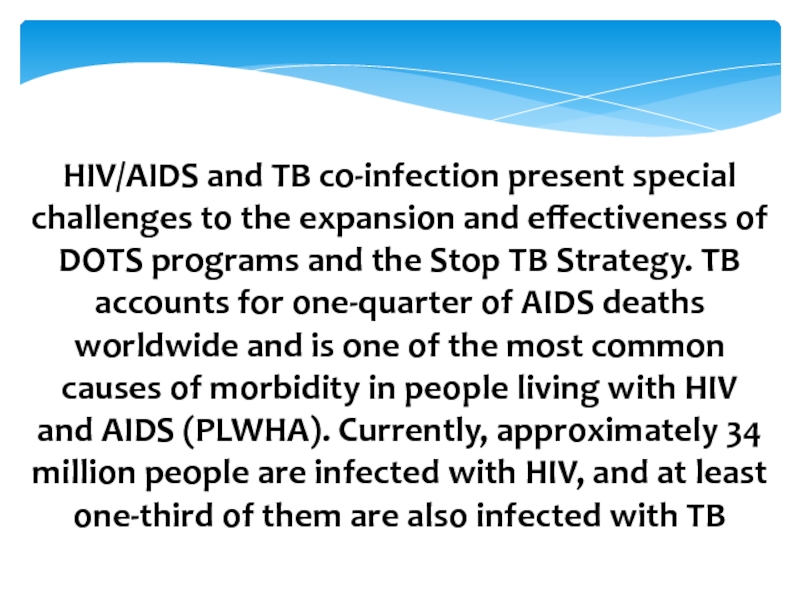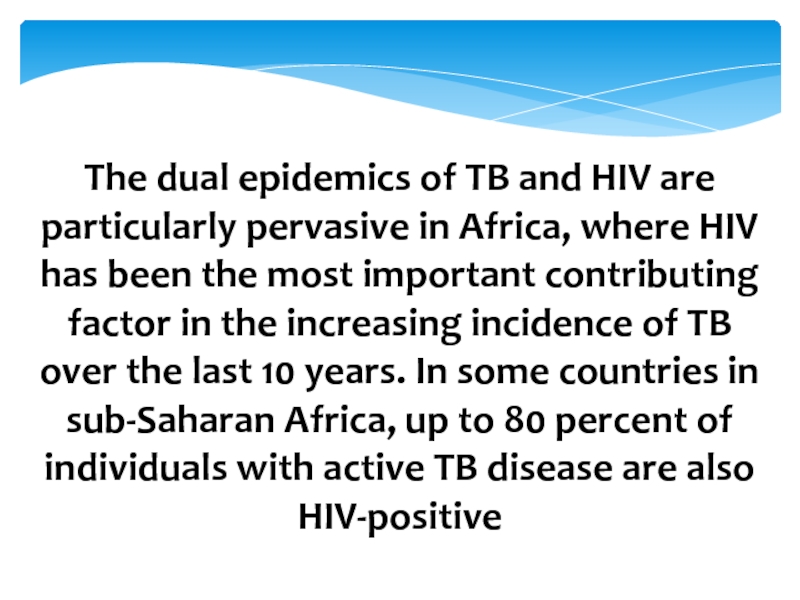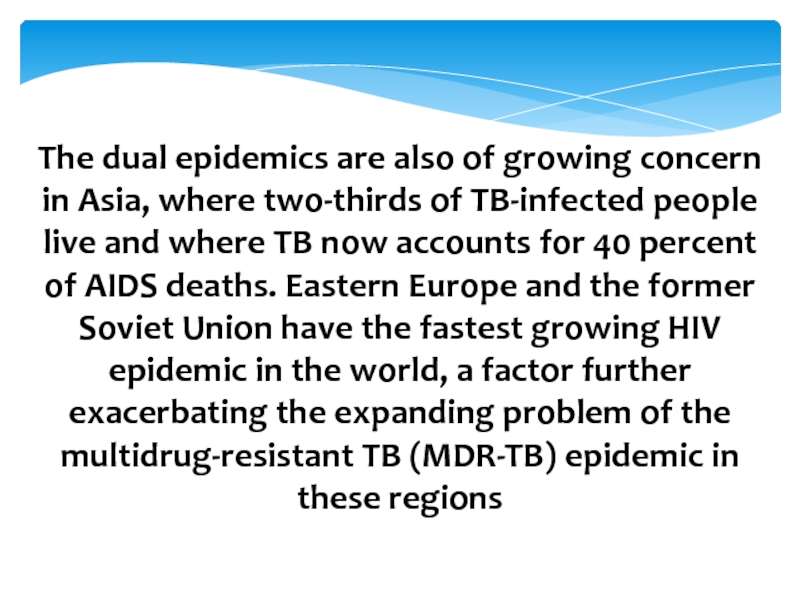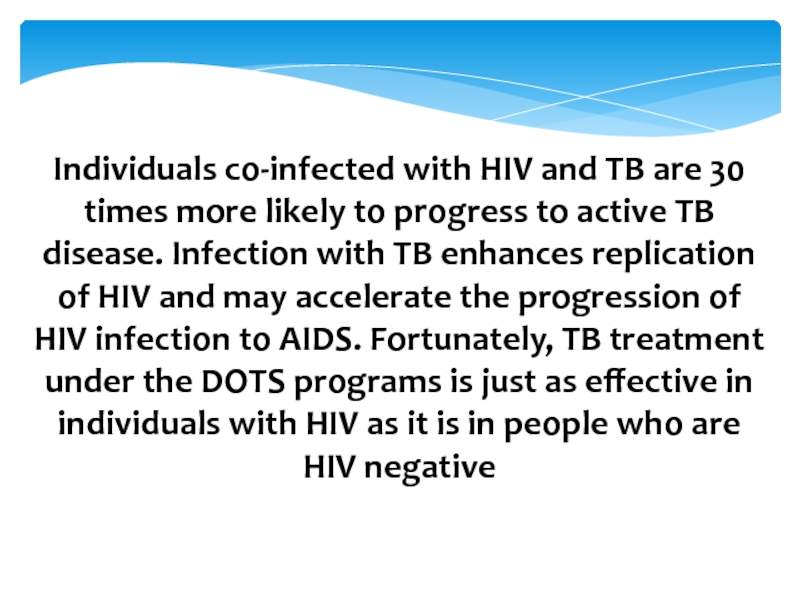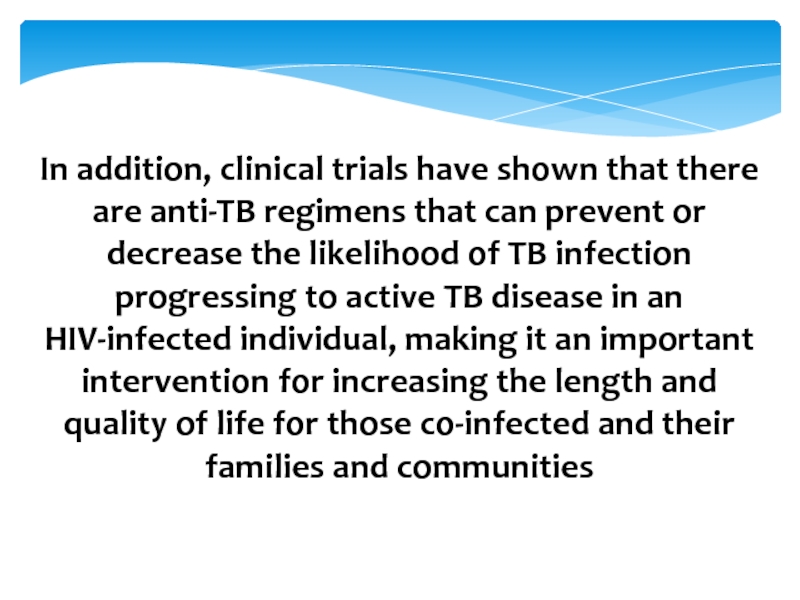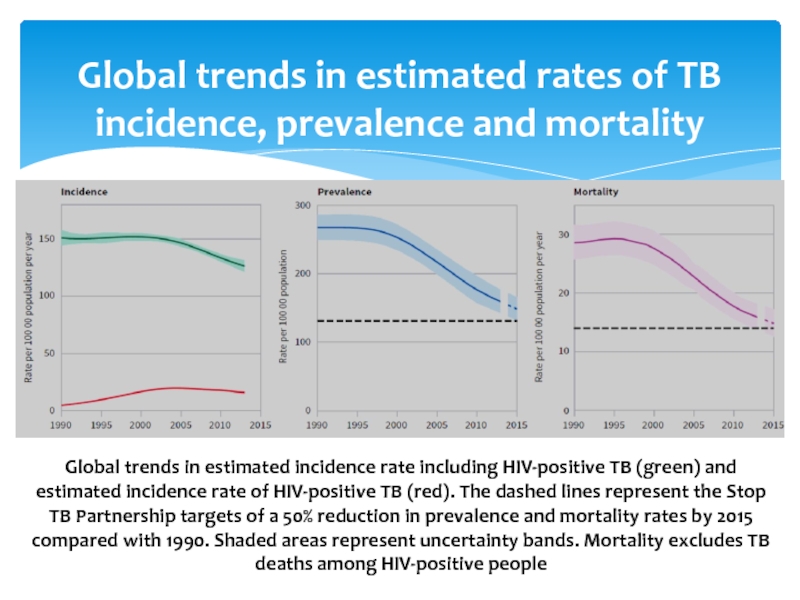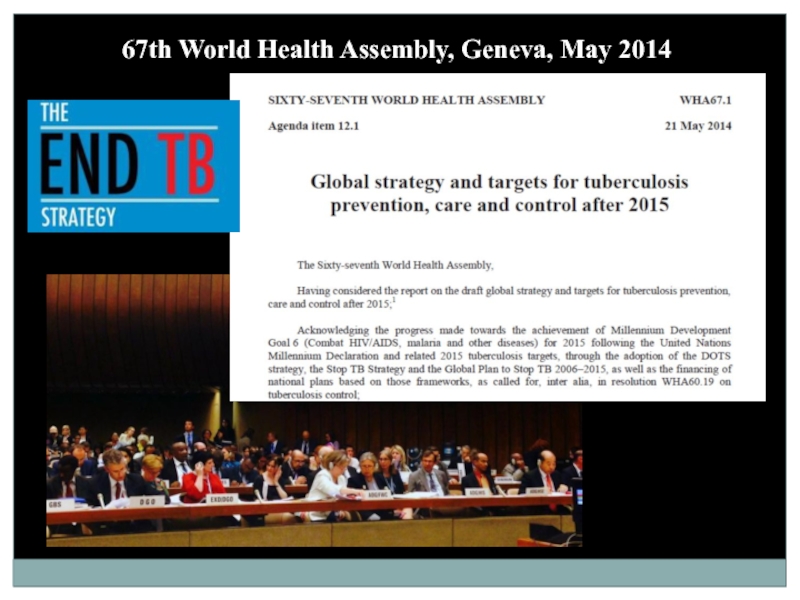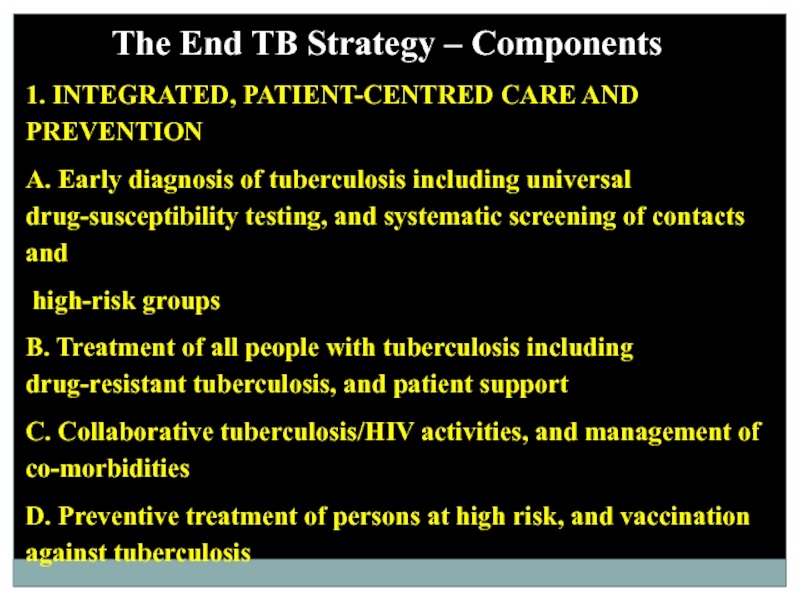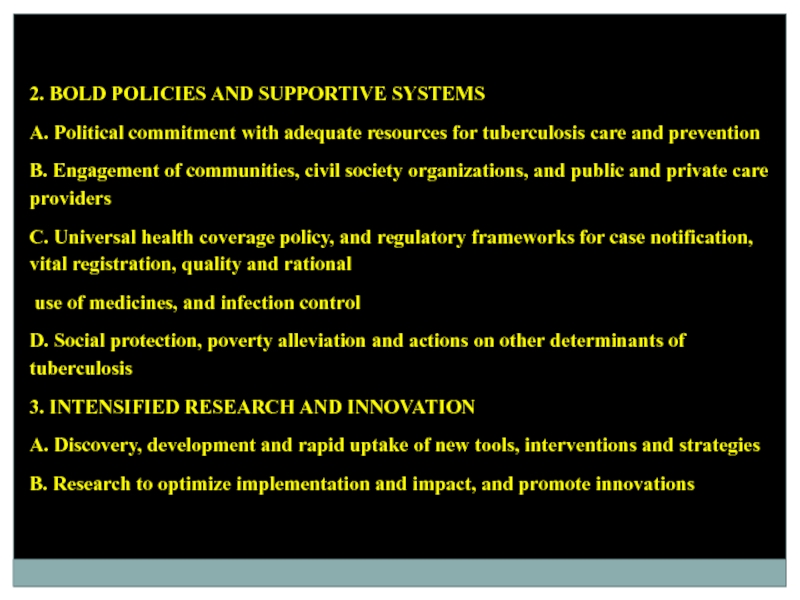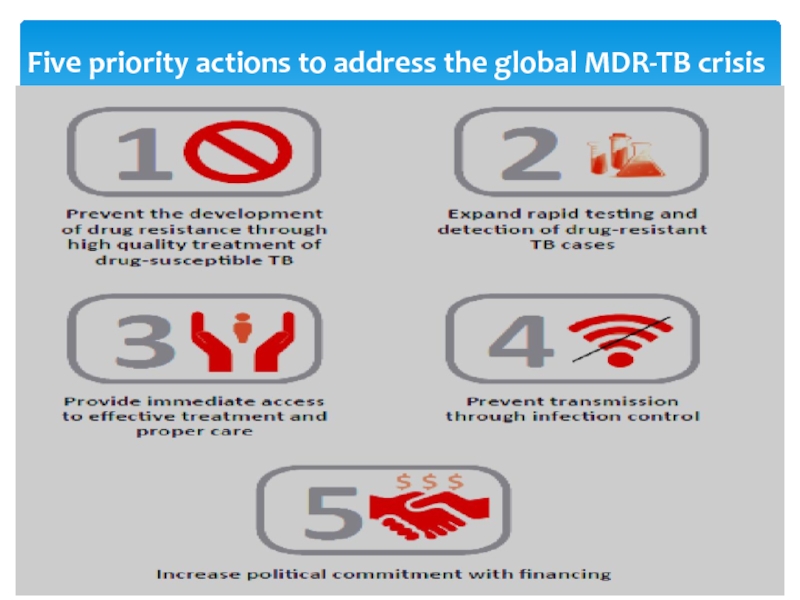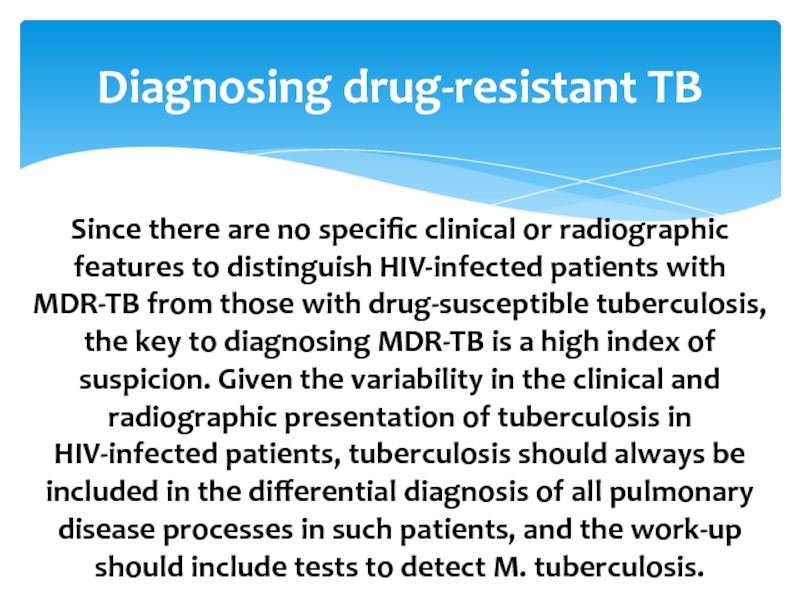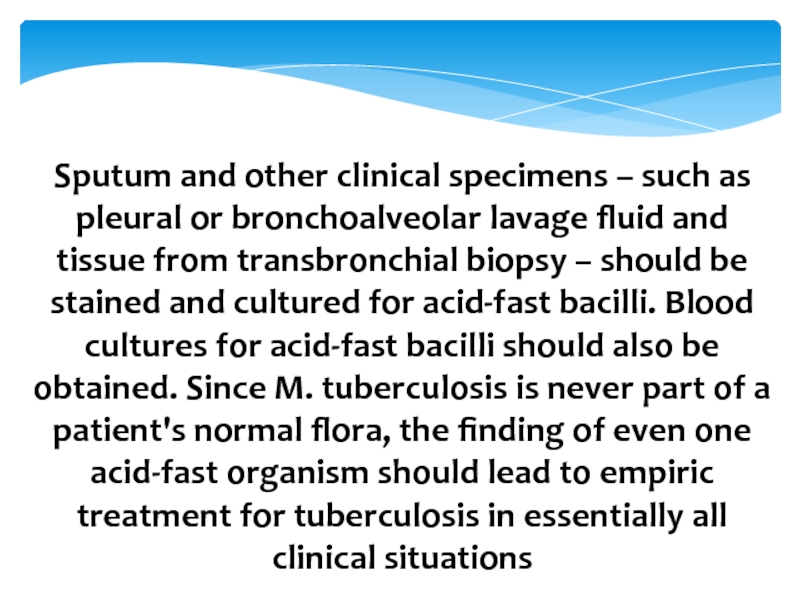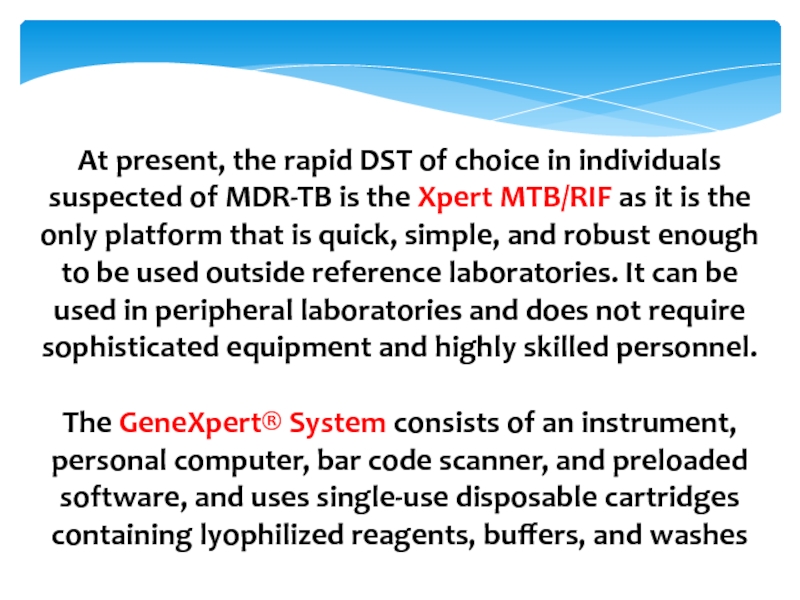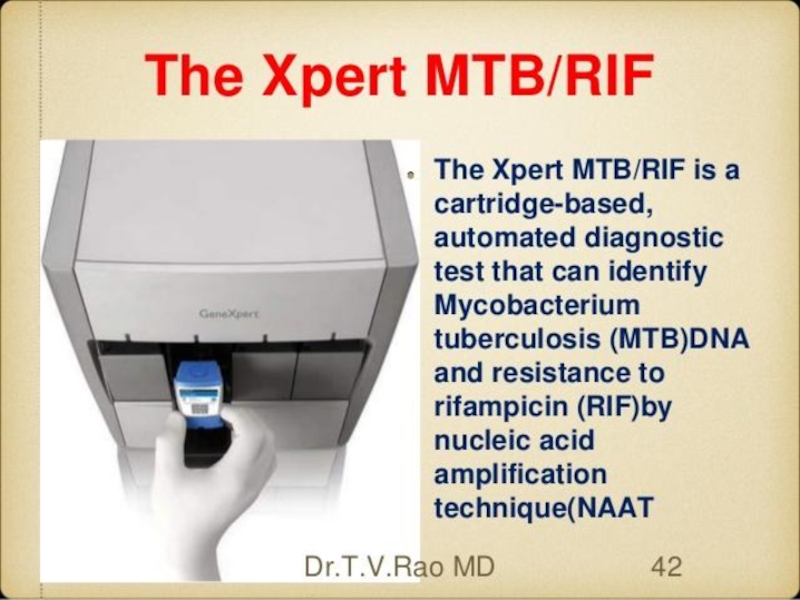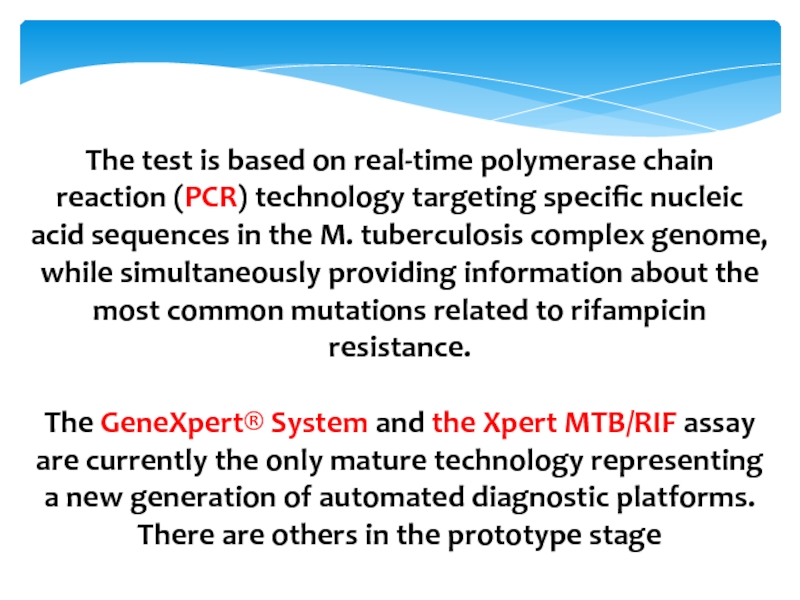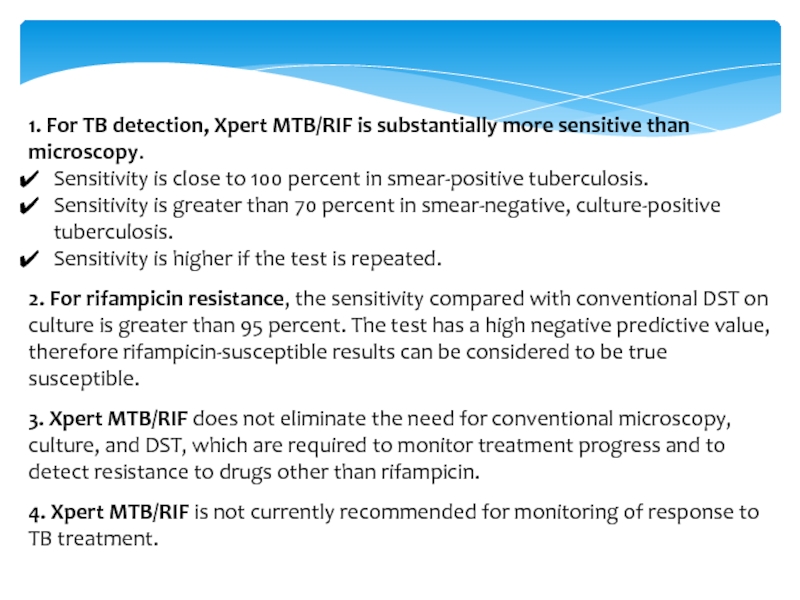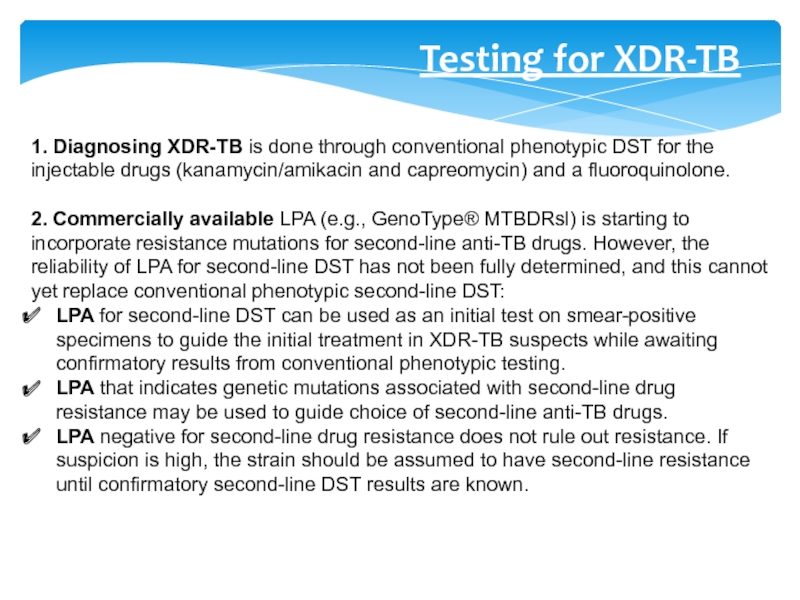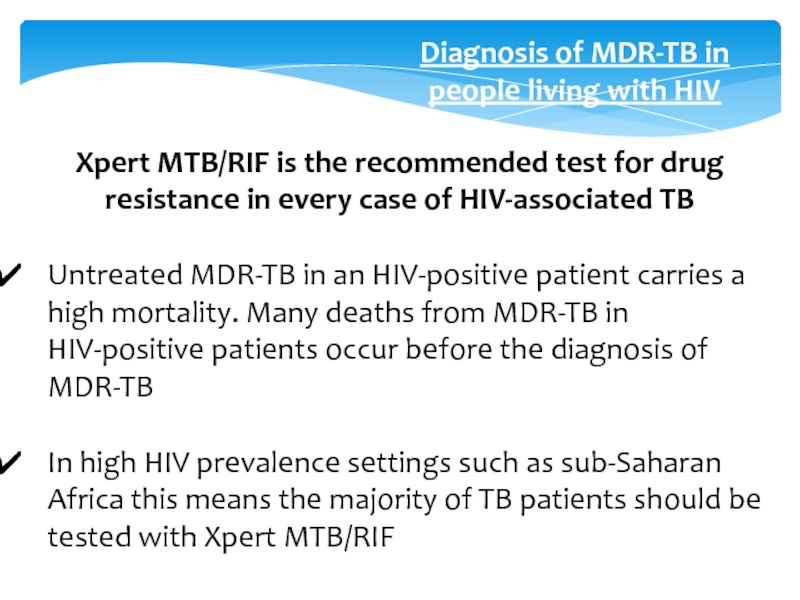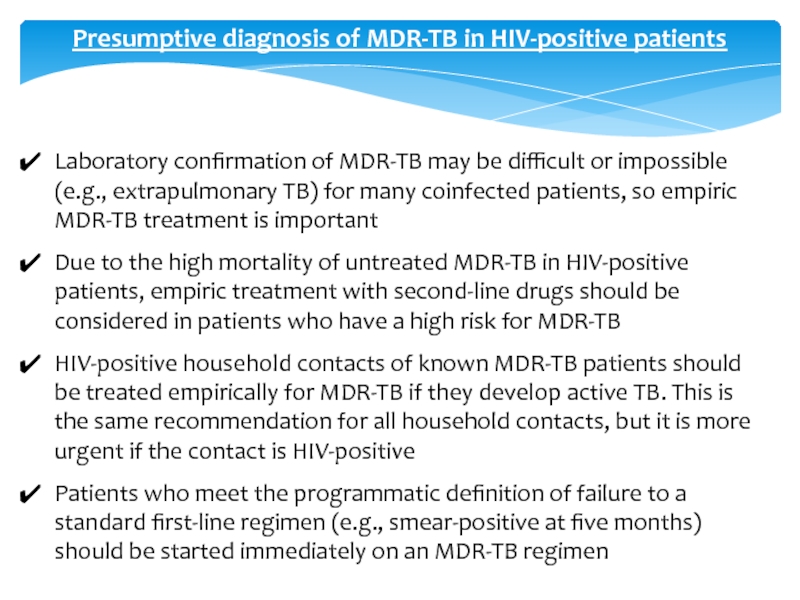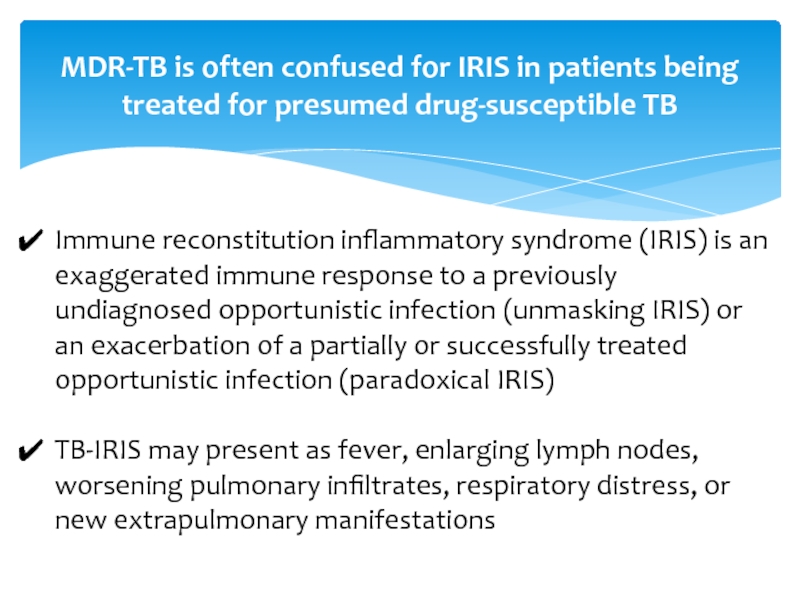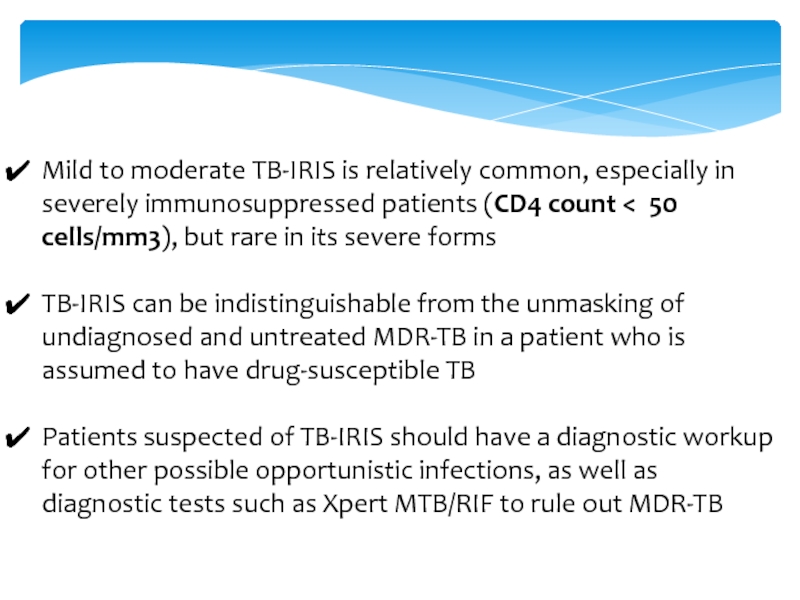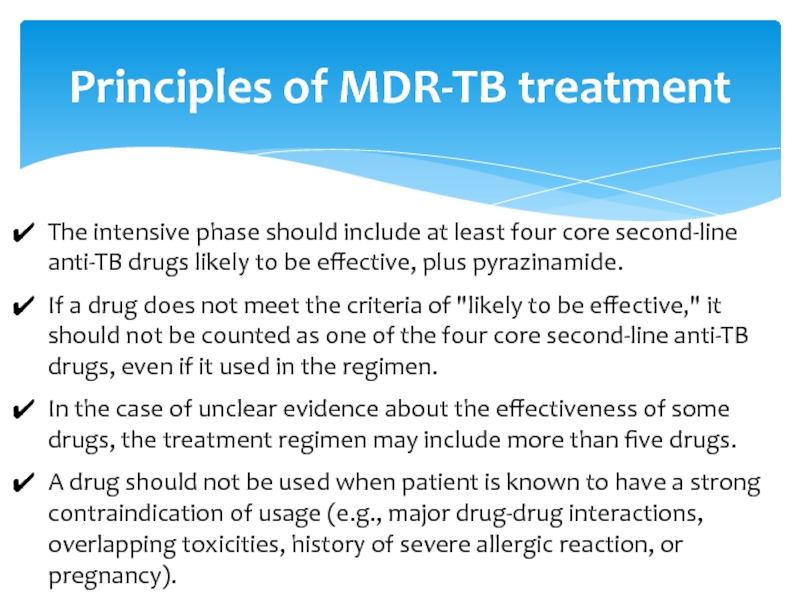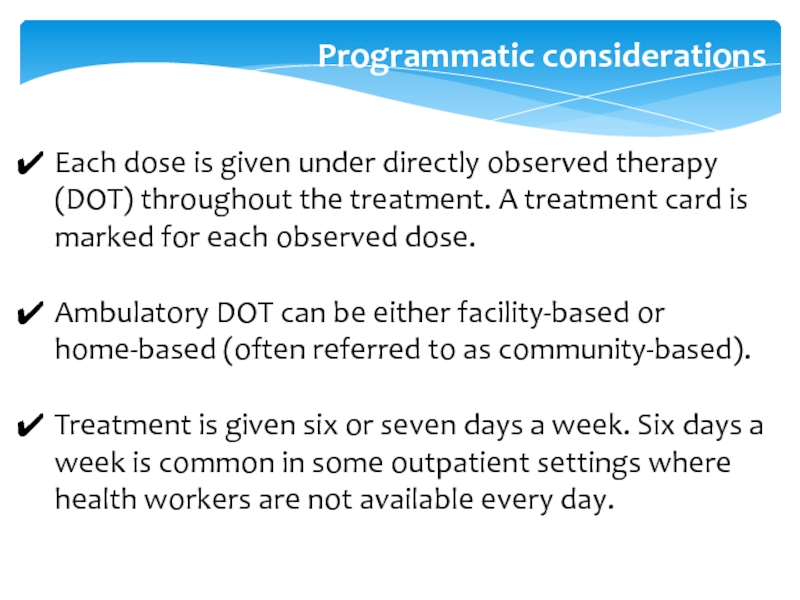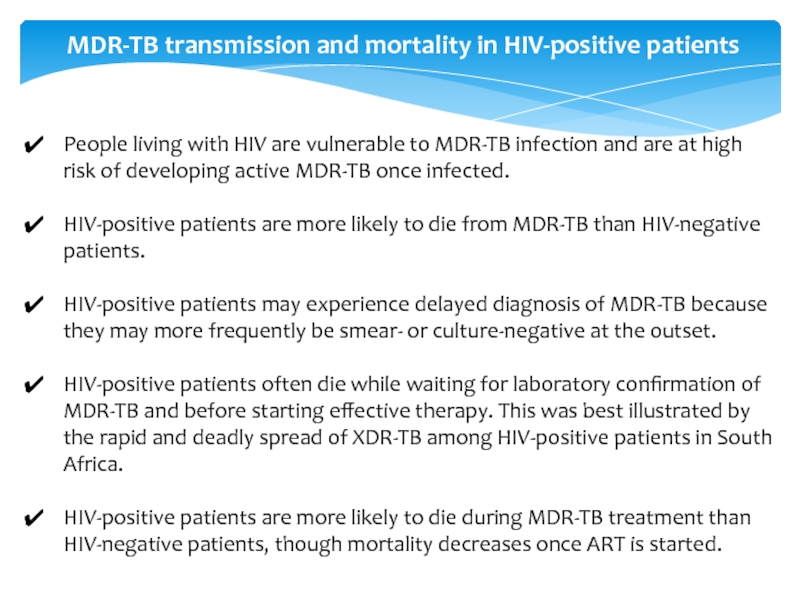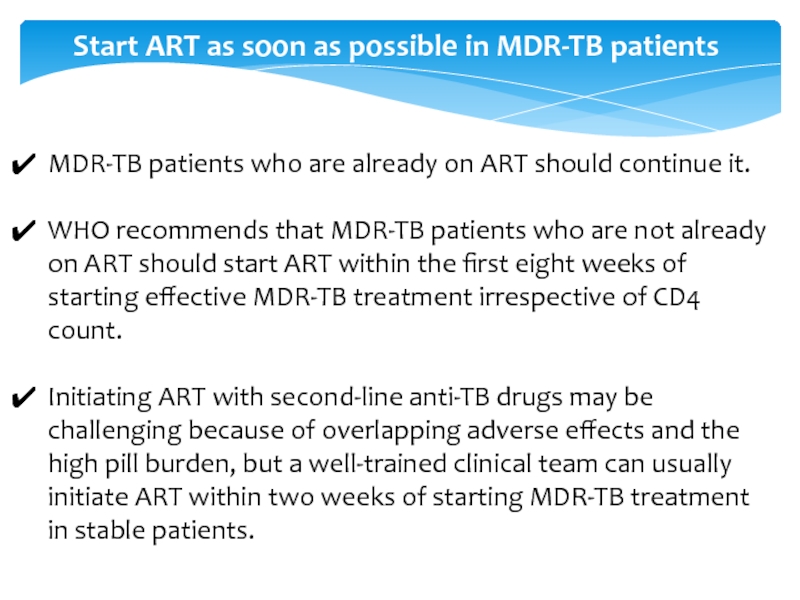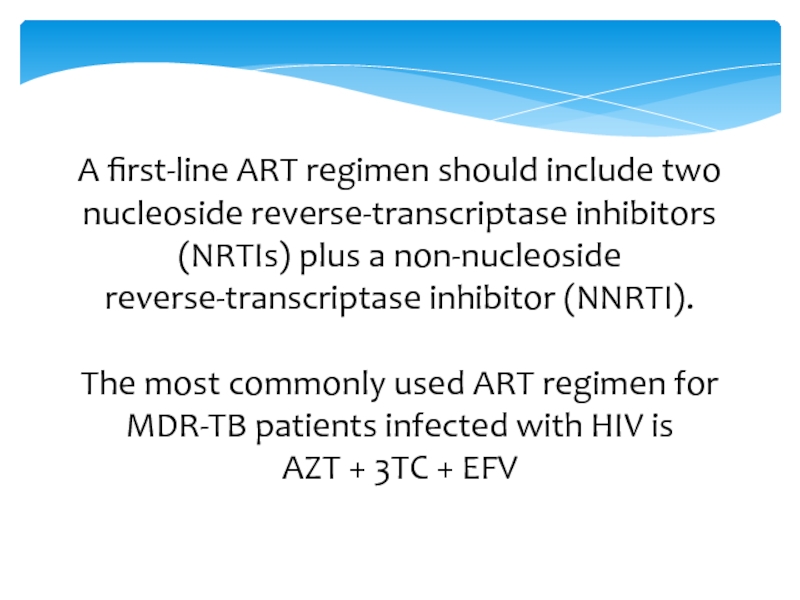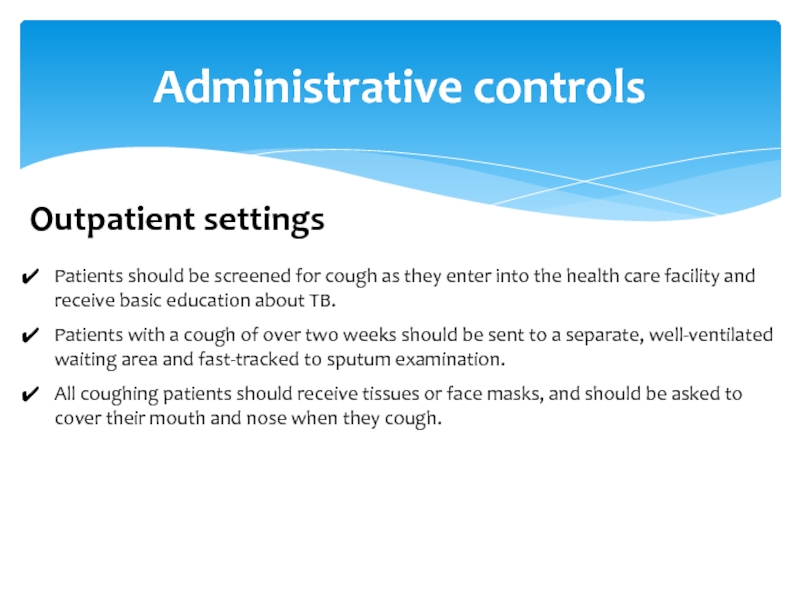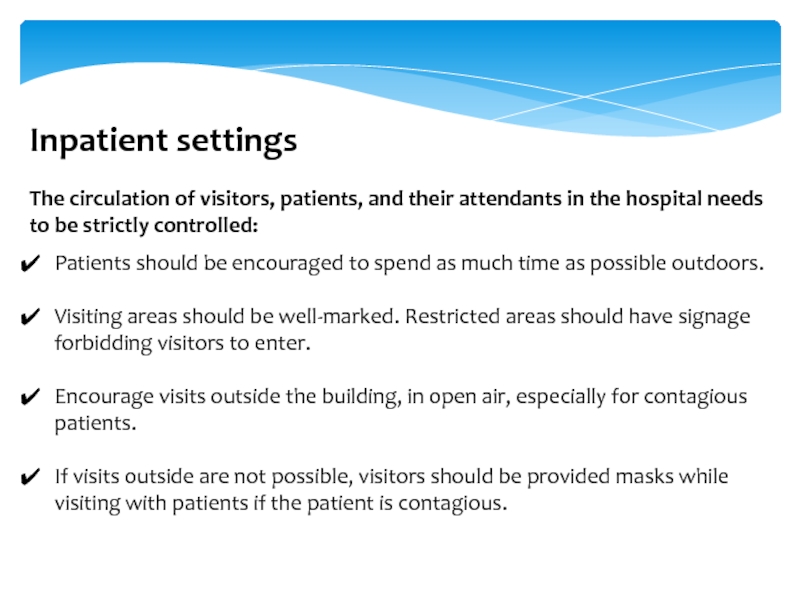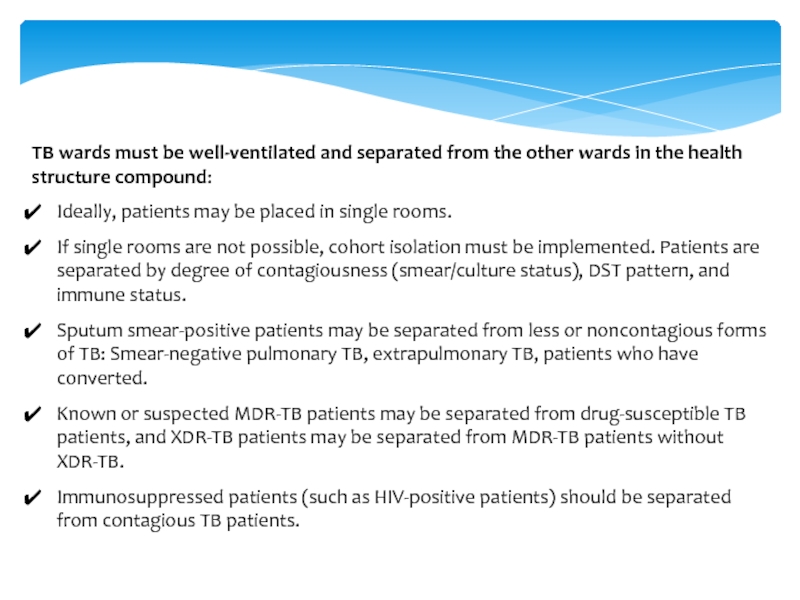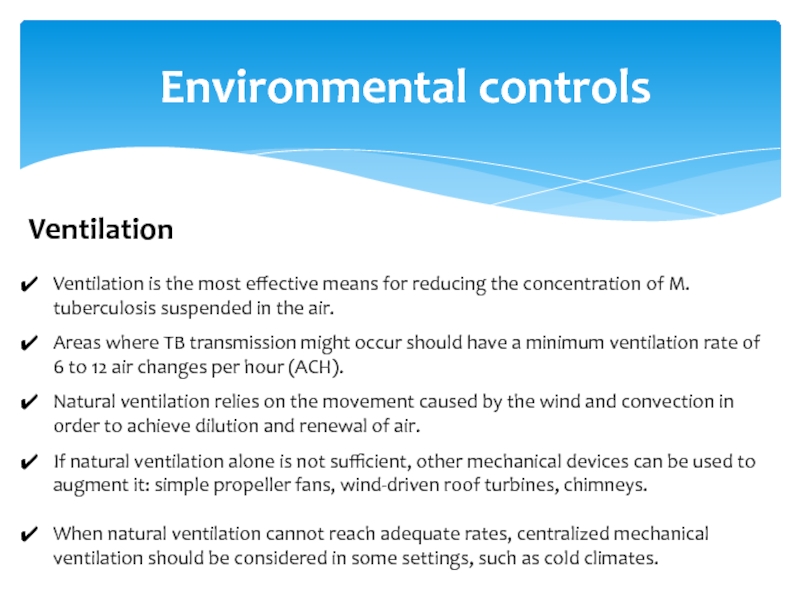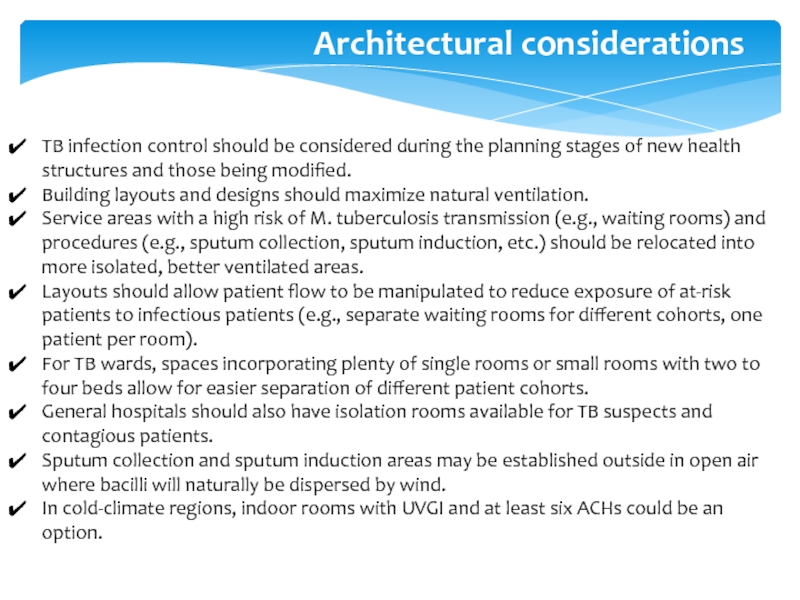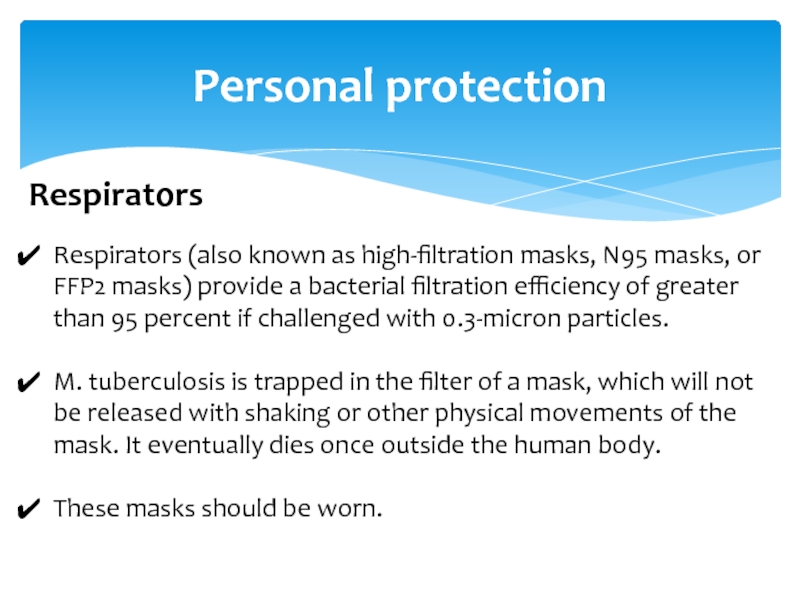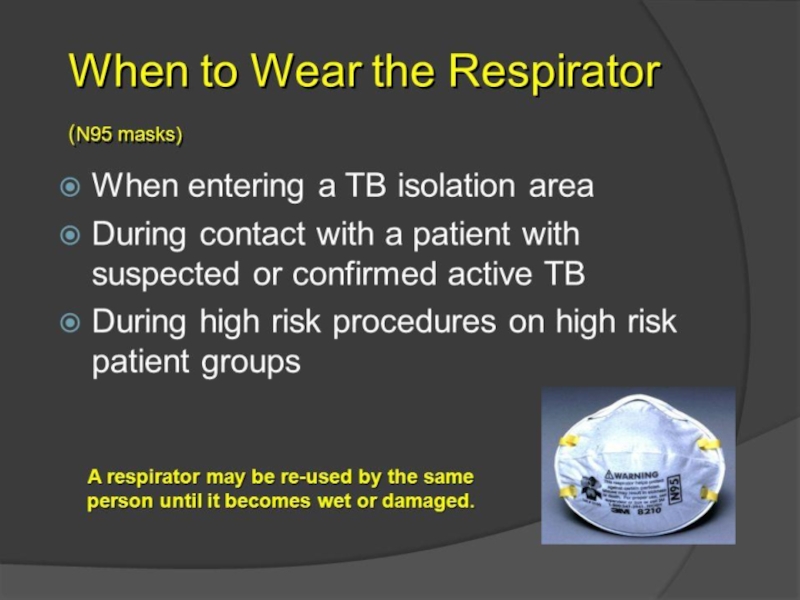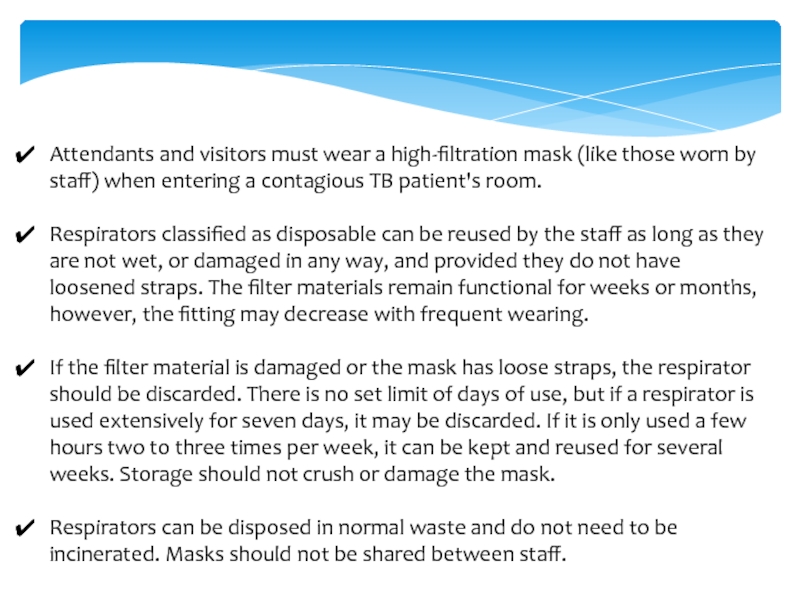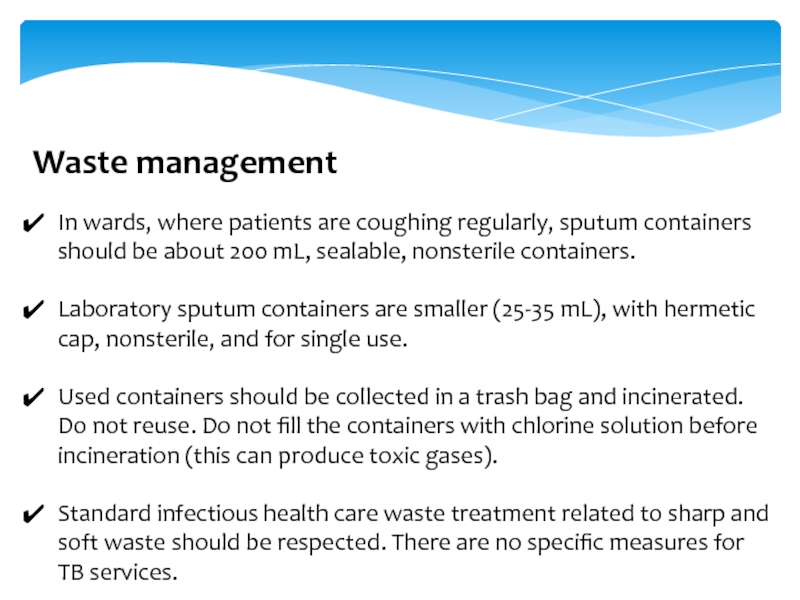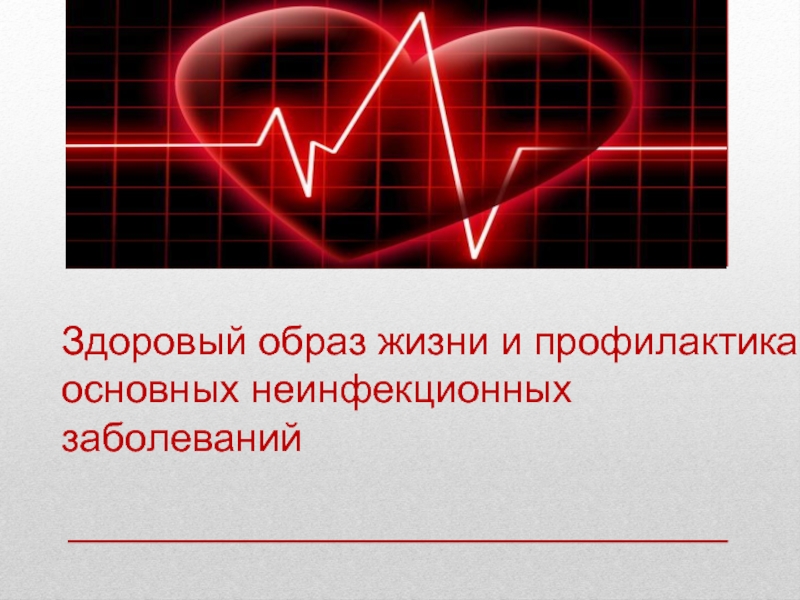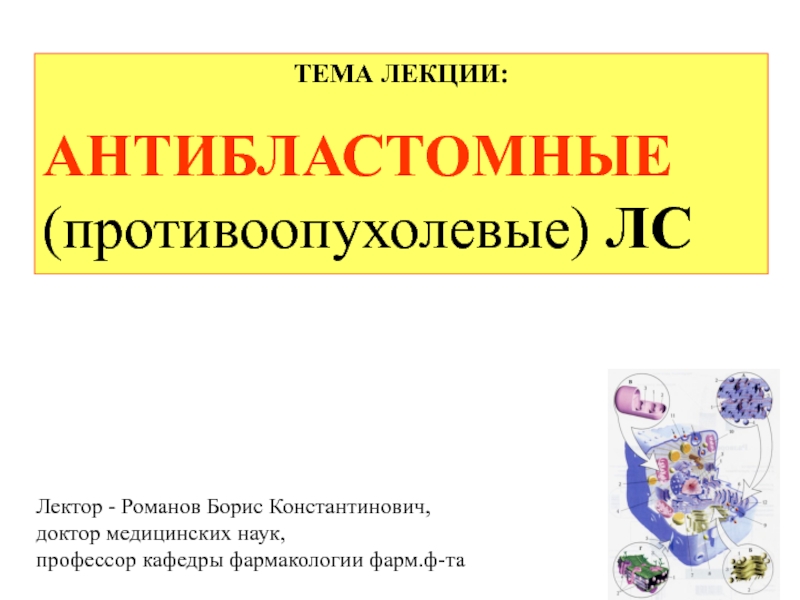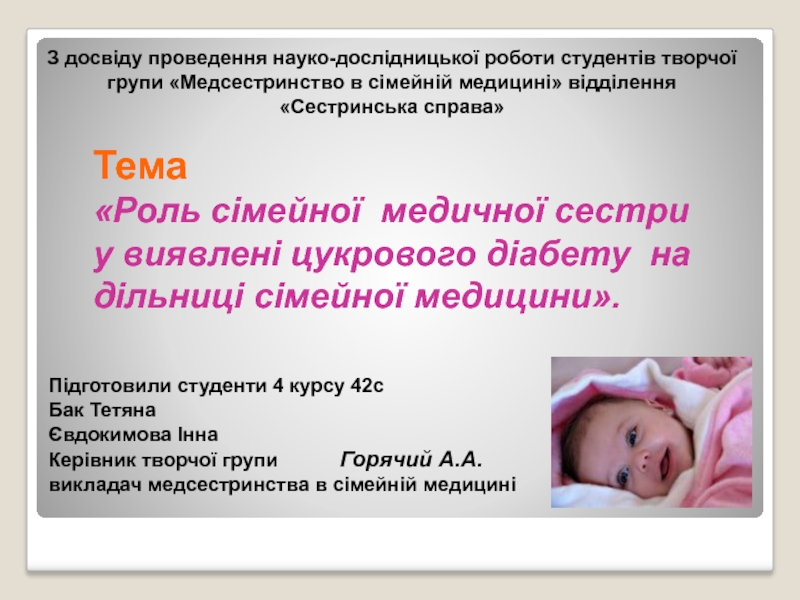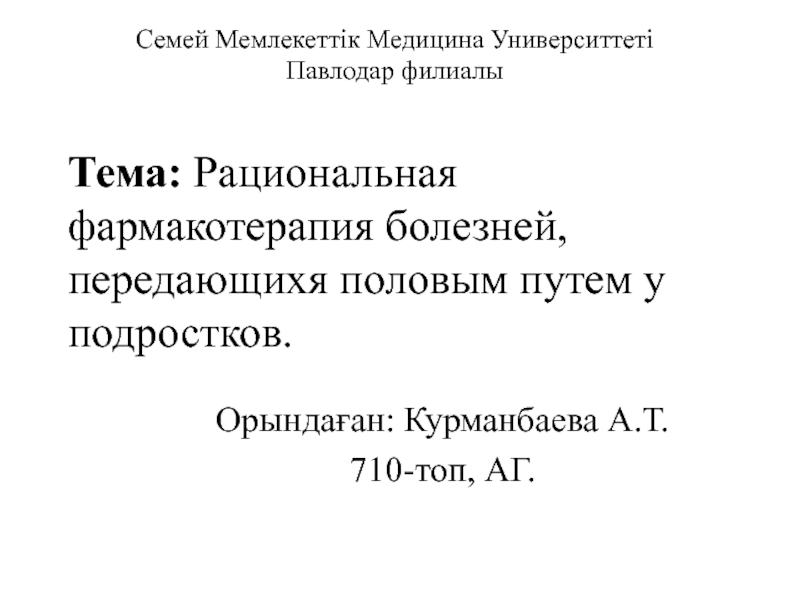- Главная
- Разное
- Дизайн
- Бизнес и предпринимательство
- Аналитика
- Образование
- Развлечения
- Красота и здоровье
- Финансы
- Государство
- Путешествия
- Спорт
- Недвижимость
- Армия
- Графика
- Культурология
- Еда и кулинария
- Лингвистика
- Английский язык
- Астрономия
- Алгебра
- Биология
- География
- Детские презентации
- Информатика
- История
- Литература
- Маркетинг
- Математика
- Медицина
- Менеджмент
- Музыка
- МХК
- Немецкий язык
- ОБЖ
- Обществознание
- Окружающий мир
- Педагогика
- Русский язык
- Технология
- Физика
- Философия
- Химия
- Шаблоны, картинки для презентаций
- Экология
- Экономика
- Юриспруденция
Multi drug resistant tuberculosis. MDR-TB. (Lecture 6) презентация
Содержание
- 1. Multi drug resistant tuberculosis. MDR-TB. (Lecture 6)
- 2. An estimated 2 billion people – one-third
- 3. Although TB is a global problem, its
- 4. TB is a major killer among women
- 5. The global resurgence of TB has been
- 6. Multidrug-resistant tuberculosis ( MDR-TB) is a form
- 7. Extensively drug-resistant TB (XDR-TB) is a
- 8. The global TB situation Estimated incidence,
- 9. Globally in 2013, an estimated 480 000
- 10. A total of 97 000 patients were
- 11. HIV/AIDS and TB co-infection present special challenges
- 12. The dual epidemics of TB and HIV
- 13. The dual epidemics are also of growing
- 14. The overlap of TB-HIV co-infection with MDR-TB
- 15. Individuals co-infected with HIV and TB are
- 16. In addition, clinical trials have shown that
- 17. Global trends in estimated rates of
- 18. 67th World Health Assembly, Geneva, May 2014
- 19. The End TB Strategy – Components 1.
- 20. 2. BOLD POLICIES AND SUPPORTIVE SYSTEMS A.
- 21. Percentage of new TB cases with
- 22. Five priority actions to address the global MDR-TB crisis
- 23. Diagnosing drug-resistant TB Since there are no
- 24. Sputum and other clinical specimens – such
- 25. At present, the rapid DST of choice
- 27. The test is based on real-time polymerase
- 28. 1. For TB detection, Xpert MTB/RIF is
- 29. 1. Diagnosing XDR-TB is done through conventional
- 30. Diagnosis of MDR-TB in people living with
- 31. Laboratory confirmation of MDR-TB may be difficult
- 32. Immune reconstitution inflammatory syndrome (IRIS) is an
- 33. Mild to moderate TB-IRIS is relatively common, especially in severely immunosuppressed patients (CD4 count
- 34. Principles of MDR-TB treatment The intensive phase
- 35. Each dose is given under directly observed
- 36. Empiric refers to the initiation of treatment
- 37. People living with HIV are vulnerable to
- 38. MDR-TB patients who are already on ART
- 39. A first-line ART regimen should include two
- 40. AZT (azt, retrovir) – a drug that
- 41. Infection control for MDR-TB
- 42. Administrative controls Outpatient settings Patients should
- 43. Inpatient settings The circulation of visitors,
- 44. TB wards must be well-ventilated and separated
- 45. Environmental controls Ventilation Ventilation is the
- 46. TB infection control should be considered during
- 47. Ultraviolet germicidal irradiation (UVGI) M. tuberculosis is
- 48. Personal protection Respirators Respirators (also known
- 50. Attendants and visitors must wear a high-filtration
- 51. Simple cloth masks and surgical masks
- 52. Waste management In wards, where patients
- 53. Thank you for your attention !
Слайд 2An estimated 2 billion people – one-third of the global population
Слайд 3Although TB is a global problem, its geographic distribution is drastically
TB is one of the top killers of women and is responsible for 500,000 of their deaths each year
Слайд 4TB is a major killer among women of reproductive age and
Only 22 high-burden countries (HBCs) account for 80 percent of the global TB burden, with half of these countries located in Asia.
In Africa, 40 countries have an estimated TB prevalence rate greater than 100/100,000 compared to an estimated prevalence rate of <5/100,000 in the United States
Слайд 5The global resurgence of TB has been fueled by a combination
The disease threatens the poorest and most marginalized, disrupts the social fabric of society, and slows or undermines gains in economic development
Слайд 6Multidrug-resistant tuberculosis ( MDR-TB) is a form of TB caused by
Слайд 7Extensively drug-resistant TB (XDR-TB)
is a rare type of MDR TB
Because XDR TB is resistant to the most potent TB drugs, patients are left with treatment options that are much less effective. XDR TB is of special concern for persons with HIV infection or other conditions that can weaken the immune system. These persons are more likely to develop TB disease once they are infected, and also have a higher risk of death once they develop TB
Слайд 8The global TB situation
Estimated
incidence, 2013
Estimated number
of deaths, 2013
1.1 million
(1.0–1.3 million)
360,000
(310,000–410,000)
210,000
(130,000–290,000)
Слайд 9Globally in 2013, an estimated 480 000 people developed MDR-TB and
The number of people diagnosed with MDR-TB tripled between 2009 and 2013, and reached 136 000 worldwide. This was equivalent to 45% of the estimated MDR-TB cases among notified TB patients. Progress in the detection of drug-resistant TB has been facilitated by the use of new rapid diagnostics.
Слайд 10A total of 97 000 patients were started on MDR-TB treatment
XDR-TB has been reported by 100 countries in 2013. On average, an estimated 9% of people with MDR-TB have XDR-TB.
Слайд 11HIV/AIDS and TB co-infection present special challenges to the expansion and
Слайд 12The dual epidemics of TB and HIV are particularly pervasive in
Слайд 13The dual epidemics are also of growing concern in Asia, where
Слайд 14The overlap of TB-HIV co-infection with MDR-TB and extensively drug-resistant TB
Слайд 15Individuals co-infected with HIV and TB are 30 times more likely
Слайд 16In addition, clinical trials have shown that there are anti-TB regimens
Слайд 17 Global trends in estimated rates of TB incidence, prevalence and mortality
Global trends in estimated incidence rate including HIV-positive TB (green) and estimated incidence rate of HIV-positive TB (red). The dashed lines represent the Stop TB Partnership targets of a 50% reduction in prevalence and mortality rates by 2015 compared with 1990. Shaded areas represent uncertainty bands. Mortality excludes TB deaths among HIV-positive people
Слайд 19The End TB Strategy – Components
1. INTEGRATED, PATIENT-CENTRED CARE AND PREVENTION
A.
high-risk groups
B. Treatment of all people with tuberculosis including drug-resistant tuberculosis, and patient support
C. Collaborative tuberculosis/HIV activities, and management of co-morbidities
D. Preventive treatment of persons at high risk, and vaccination against tuberculosis
Слайд 202. BOLD POLICIES AND SUPPORTIVE SYSTEMS
A. Political commitment with adequate resources
B. Engagement of communities, civil society organizations, and public and private care providers
C. Universal health coverage policy, and regulatory frameworks for case notification, vital registration, quality and rational
use of medicines, and infection control
D. Social protection, poverty alleviation and actions on other determinants of tuberculosis
3. INTENSIFIED RESEARCH AND INNOVATION
A. Discovery, development and rapid uptake of new tools, interventions and strategies
B. Research to optimize implementation and impact, and promote innovations
Слайд 21Percentage of new TB cases
with MDR-TB (WHO 2014)
The boundaries and
Слайд 23Diagnosing drug-resistant TB
Since there are no specific clinical or radiographic features
Слайд 24Sputum and other clinical specimens – such as pleural or bronchoalveolar
Слайд 25At present, the rapid DST of choice in individuals suspected of
The GeneXpert® System consists of an instrument, personal computer, bar code scanner, and preloaded software, and uses single-use disposable cartridges containing lyophilized reagents, buffers, and washes
Слайд 27The test is based on real-time polymerase chain reaction (PCR) technology
The GeneXpert® System and the Xpert MTB/RIF assay are currently the only mature technology representing a new generation of automated diagnostic platforms. There are others in the prototype stage
Слайд 281. For TB detection, Xpert MTB/RIF is substantially more sensitive than
Sensitivity is close to 100 percent in smear-positive tuberculosis.
Sensitivity is greater than 70 percent in smear-negative, culture-positive tuberculosis.
Sensitivity is higher if the test is repeated.
2. For rifampicin resistance, the sensitivity compared with conventional DST on culture is greater than 95 percent. The test has a high negative predictive value, therefore rifampicin-susceptible results can be considered to be true susceptible.
3. Xpert MTB/RIF does not eliminate the need for conventional microscopy, culture, and DST, which are required to monitor treatment progress and to detect resistance to drugs other than rifampicin.
4. Xpert MTB/RIF is not currently recommended for monitoring of response to TB treatment.
Слайд 291. Diagnosing XDR-TB is done through conventional phenotypic DST for the
2. Commercially available LPA (e.g., GenoType® MTBDRsl) is starting to incorporate resistance mutations for second-line anti-TB drugs. However, the reliability of LPA for second-line DST has not been fully determined, and this cannot yet replace conventional phenotypic second-line DST:
LPA for second-line DST can be used as an initial test on smear-positive specimens to guide the initial treatment in XDR-TB suspects while awaiting confirmatory results from conventional phenotypic testing.
LPA that indicates genetic mutations associated with second-line drug resistance may be used to guide choice of second-line anti-TB drugs.
LPA negative for second-line drug resistance does not rule out resistance. If suspicion is high, the strain should be assumed to have second-line resistance until confirmatory second-line DST results are known.
Testing for XDR-TB
Слайд 30Diagnosis of MDR-TB in people living with HIV
Xpert MTB/RIF is the
Untreated MDR-TB in an HIV-positive patient carries a high mortality. Many deaths from MDR-TB in HIV-positive patients occur before the diagnosis of MDR-TB
In high HIV prevalence settings such as sub-Saharan Africa this means the majority of TB patients should be tested with Xpert MTB/RIF
Слайд 31Laboratory confirmation of MDR-TB may be difficult or impossible (e.g., extrapulmonary
Due to the high mortality of untreated MDR-TB in HIV-positive patients, empiric treatment with second-line drugs should be considered in patients who have a high risk for MDR-TB
HIV-positive household contacts of known MDR-TB patients should be treated empirically for MDR-TB if they develop active TB. This is the same recommendation for all household contacts, but it is more urgent if the contact is HIV-positive
Patients who meet the programmatic definition of failure to a standard first-line regimen (e.g., smear-positive at five months) should be started immediately on an MDR-TB regimen
Presumptive diagnosis of MDR-TB in HIV-positive patients
Слайд 32Immune reconstitution inflammatory syndrome (IRIS) is an exaggerated immune response to
TB-IRIS may present as fever, enlarging lymph nodes, worsening pulmonary infiltrates, respiratory distress, or new extrapulmonary manifestations
MDR-TB is often confused for IRIS in patients being treated for presumed drug-susceptible TB
Слайд 33Mild to moderate TB-IRIS is relatively common, especially in severely immunosuppressed
TB-IRIS can be indistinguishable from the unmasking of undiagnosed and untreated MDR-TB in a patient who is assumed to have drug-susceptible TB
Patients suspected of TB-IRIS should have a diagnostic workup for other possible opportunistic infections, as well as diagnostic tests such as Xpert MTB/RIF to rule out MDR-TB
Слайд 34Principles of MDR-TB treatment
The intensive phase should include at least four
If a drug does not meet the criteria of "likely to be effective," it should not be counted as one of the four core second-line anti-TB drugs, even if it used in the regimen.
In the case of unclear evidence about the effectiveness of some drugs, the treatment regimen may include more than five drugs.
A drug should not be used when patient is known to have a strong contraindication of usage (e.g., major drug-drug interactions, overlapping toxicities, history of severe allergic reaction, or pregnancy).
Слайд 35Each dose is given under directly observed therapy (DOT) throughout the
Ambulatory DOT can be either facility-based or home-based (often referred to as community-based).
Treatment is given six or seven days a week. Six days a week is common in some outpatient settings where health workers are not available every day.
Programmatic considerations
Слайд 36Empiric refers to the initiation of treatment prior to determination of
Empiric regimens can be standardized or individualized.
For example, an empiric XDR regimen refers to the use of a regimen designed to treat XDR-TB before the diagnosis of XDR-TB is made.
Empiric treatment
Слайд 37People living with HIV are vulnerable to MDR-TB infection and are
HIV-positive patients are more likely to die from MDR-TB than HIV-negative patients.
HIV-positive patients may experience delayed diagnosis of MDR-TB because they may more frequently be smear- or culture-negative at the outset.
HIV-positive patients often die while waiting for laboratory confirmation of MDR-TB and before starting effective therapy. This was best illustrated by the rapid and deadly spread of XDR-TB among HIV-positive patients in South Africa.
HIV-positive patients are more likely to die during MDR-TB treatment than HIV-negative patients, though mortality decreases once ART is started.
MDR-TB transmission and mortality in HIV-positive patients
Слайд 38MDR-TB patients who are already on ART should continue it.
WHO recommends
Initiating ART with second-line anti-TB drugs may be challenging because of overlapping adverse effects and the high pill burden, but a well-trained clinical team can usually initiate ART within two weeks of starting MDR-TB treatment in stable patients.
Start ART as soon as possible in MDR-TB patients
Слайд 39A first-line ART regimen should include two nucleoside reverse-transcriptase inhibitors (NRTIs)
The most commonly used ART regimen for MDR-TB patients infected with HIV is
AZT + 3TC + EFV
Слайд 40AZT (azt, retrovir) – a drug that suppresses the replication (reproduction)
EPIVIR 3TC – leads to premature termination of replication and thus inhibit the synthesis of HBV DNA
Еfavirenz (EFV) - efavirenz is used to treat HIV infection. It is never used alone and is always given in combination with other drugs. The decision on when to start treatment should take into account CD4 count, HIV viral load, treatment history, resistance profiles and patient preference.
Слайд 42Administrative controls
Outpatient settings
Patients should be screened for cough as they enter
Patients with a cough of over two weeks should be sent to a separate, well-ventilated waiting area and fast-tracked to sputum examination.
All coughing patients should receive tissues or face masks, and should be asked to cover their mouth and nose when they cough.
Слайд 43Inpatient settings
The circulation of visitors, patients, and their attendants in the
Patients should be encouraged to spend as much time as possible outdoors.
Visiting areas should be well-marked. Restricted areas should have signage forbidding visitors to enter.
Encourage visits outside the building, in open air, especially for contagious patients.
If visits outside are not possible, visitors should be provided masks while visiting with patients if the patient is contagious.
Слайд 44TB wards must be well-ventilated and separated from the other wards
Ideally, patients may be placed in single rooms.
If single rooms are not possible, cohort isolation must be implemented. Patients are separated by degree of contagiousness (smear/culture status), DST pattern, and immune status.
Sputum smear-positive patients may be separated from less or noncontagious forms of TB: Smear-negative pulmonary TB, extrapulmonary TB, patients who have converted.
Known or suspected MDR-TB patients may be separated from drug-susceptible TB patients, and XDR-TB patients may be separated from MDR-TB patients without XDR-TB.
Immunosuppressed patients (such as HIV-positive patients) should be separated from contagious TB patients.
Слайд 45 Environmental controls
Ventilation
Ventilation is the most effective means for reducing the concentration
Areas where TB transmission might occur should have a minimum ventilation rate of 6 to 12 air changes per hour (ACH).
Natural ventilation relies on the movement caused by the wind and convection in order to achieve dilution and renewal of air.
If natural ventilation alone is not sufficient, other mechanical devices can be used to augment it: simple propeller fans, wind-driven roof turbines, chimneys.
When natural ventilation cannot reach adequate rates, centralized mechanical ventilation should be considered in some settings, such as cold climates.
Слайд 46TB infection control should be considered during the planning stages of
Building layouts and designs should maximize natural ventilation.
Service areas with a high risk of M. tuberculosis transmission (e.g., waiting rooms) and procedures (e.g., sputum collection, sputum induction, etc.) should be relocated into more isolated, better ventilated areas.
Layouts should allow patient flow to be manipulated to reduce exposure of at-risk patients to infectious patients (e.g., separate waiting rooms for different cohorts, one patient per room).
For TB wards, spaces incorporating plenty of single rooms or small rooms with two to four beds allow for easier separation of different patient cohorts.
General hospitals should also have isolation rooms available for TB suspects and contagious patients.
Sputum collection and sputum induction areas may be established outside in open air where bacilli will naturally be dispersed by wind.
In cold-climate regions, indoor rooms with UVGI and at least six ACHs could be an option.
Architectural considerations
Слайд 47Ultraviolet germicidal irradiation (UVGI)
M. tuberculosis is sensitive to germicidal radiation of
UVGI lamps are reserved for high-risk areas (sputum collection, sputum induction areas, poorly ventilated spaces with less than six ACHs, etc.) where other environmental measures are not sufficient due to climatic (hot arid or cold regions) or structural constraints.
UV lamp usage requires specific procedures and present several main challenges.
Слайд 48Personal protection
Respirators
Respirators (also known as high-filtration masks, N95 masks, or FFP2
M. tuberculosis is trapped in the filter of a mask, which will not be released with shaking or other physical movements of the mask. It eventually dies once outside the human body.
These masks should be worn.
Слайд 50Attendants and visitors must wear a high-filtration mask (like those worn
Respirators classified as disposable can be reused by the staff as long as they are not wet, or damaged in any way, and provided they do not have loosened straps. The filter materials remain functional for weeks or months, however, the fitting may decrease with frequent wearing.
If the filter material is damaged or the mask has loose straps, the respirator should be discarded. There is no set limit of days of use, but if a respirator is used extensively for seven days, it may be discarded. If it is only used a few hours two to three times per week, it can be kept and reused for several weeks. Storage should not crush or damage the mask.
Respirators can be disposed in normal waste and do not need to be incinerated. Masks should not be shared between staff.
Слайд 51Simple cloth masks and surgical masks
Contagious patients must wear a simple
Слайд 52Waste management
In wards, where patients are coughing regularly, sputum containers should
Laboratory sputum containers are smaller (25-35 mL), with hermetic cap, nonsterile, and for single use.
Used containers should be collected in a trash bag and incinerated. Do not reuse. Do not fill the containers with chlorine solution before incineration (this can produce toxic gases).
Standard infectious health care waste treatment related to sharp and soft waste should be respected. There are no specific measures for TB services.
